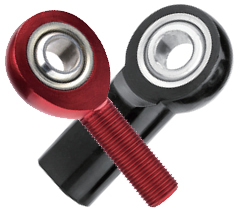
Rod ends are commonly used as articulating joints. Also known as heim joints, they connect two or more parts while simultaneously allowing for limited movement.
A typical rod end features a head with a shank and a bearing. The shank and head form the housing. While most rod ends share a similar design, they are available in different types. There are several things you need to know when choosing rod ends.
Internal vs External Threading
All rod ends have threading. Threading is essentially what allows them to connect other parts. With that said, some rod ends have internal threading, whereas others have external threading.
You should choose rod ends with the right type of threading. If you’re planning to connect them to a threaded hole, you’ll typically need rod ends with external threading. If you’re planning to connect them to a threaded shaft, conversely, you’ll need rod ends with internal threading.
Self-Lubricating
You may want to choose self-lubricating rod ends. Rod ends require lubrication to reduce friction. As the parts to which they are connected move, rod ends will generate friction. Over time, this friction can wear down rod ends. Lubrication will reduce friction while subsequently promoting a longer lifespan.
Some rod ends are self-lubricating. You don’t have to lubricate them. Self-lubricating rod ends are made with lubrication, making them a convenient alternative to standard rod ends.
Left vs Right Hand
There are left-hand rod ends, and there are right-hand rod ends. They both feature threading. As previously mentioned, some rod ends have internal threading, and other rod ends have external threading. But the way in which they connect to other parts will vary depending on whether they are left-hand or right-hand rod ends.
Left-hand rod ends feature left-hand threading. Right-hand rod ends feature right-hand threading.
Material
Rod ends are available in different materials. You can find them in aluminum, chrome steel, carbon steel and more.
Aluminum rod ends are a popular choice. They are lightweight, inexpensive, durable and resistant to corrosion. Steel rod ends are another great option. They are typically stronger than aluminum rod ends.
In Conclusion
Whether you’re looking to buy a single rod end or hundreds, you’ll need to choose the right type. Some rod ends have internal threading, whereas others have external threading. You can also find rod ends in different hand threading, materials and more. Referring to the tips listed here will help you choose the right rod ends.
